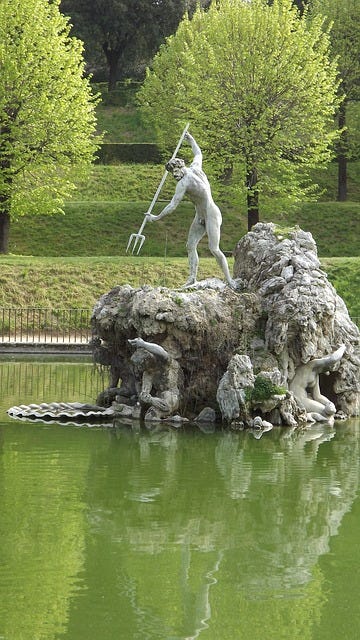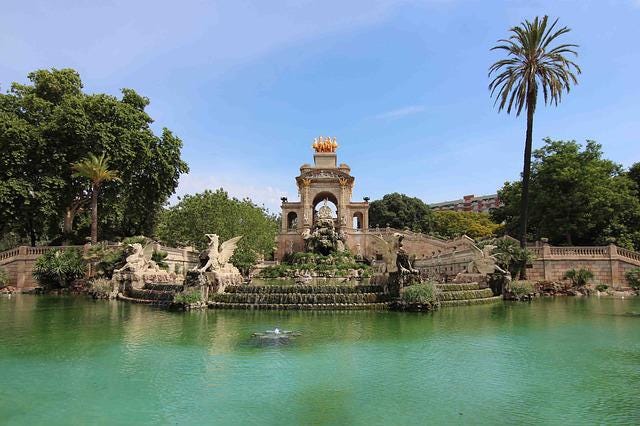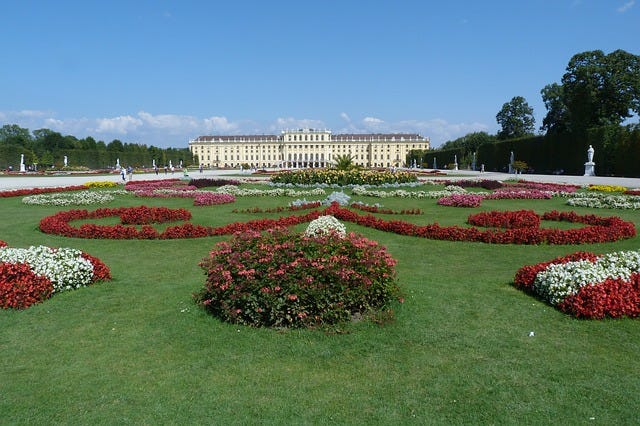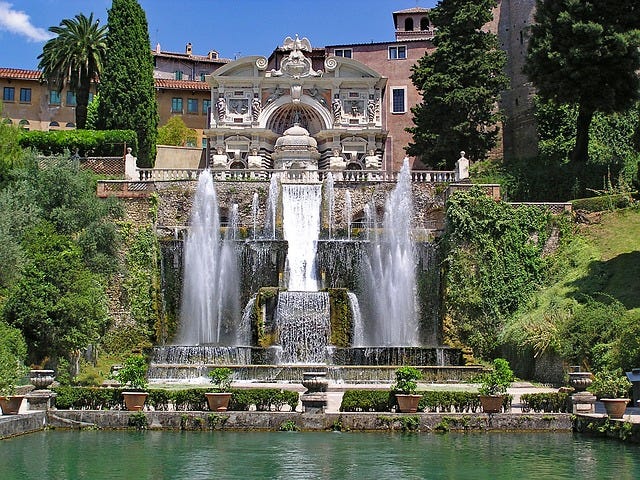The Best Gardens in Europe to Visit, from East to West
In this article, I will provide you with a list of the most beautiful gardens in Europe IMHO. They are NOT by order of preference but by alphabetic order.
Why?
Because gardens have a certain beauty to them that draws me in. But I’m not the type of person who goes to a park and just sits on the first bench.I enjoy walking around them, exploring their nuances, touching the leaves of their trees (when permitted, of course), and inhaling deeply to discover their scents.
It gives me an inexplicable calmness (and according to Cal Newport, it is also very beneficial to our brain).
That is why, whenever possible, I try to visit iconic gardens during my travels around the world.
And, with all due respect to other cultures, the Europeans excelled at creating scenic, aesthetically pleasing green spaces.
I hope you enjoy it, and any comments or suggestions are welcome!
Listen to "The 10 Most Beautiful Gardens in Europe🌻" on Spreaker.Boboli Gardens (Florence, Italy)

Florence is a popular tourist destination, but it also boasts some beautiful gardens. The Boboli Gardens, part of the Pitti Palace complex in Florence, are well worth a visit.
Visit the website for hours and rates, and use Google Maps to get a glimpse of its splendor. In the high season, admission to the gardens costs EUR10, while in the off-season, it costs less. The ticket includes admission to the Porcelain Museum.
The Boboli Gardens in Florence are more akin to an outdoor museum than a garden, and they serve as inspiration for several well-known European gardens.
The Medici family bought the property and commissioned Niccolo Pericoli to develop the region in the early sixteenth century. Pericoli worked on it until his death, and his work was finished by Bartolomeo Ammannati. Later, still in the sixteenth century, Cosimo I de Medici bought the gardens and decided to establish their new ducal residence in the Pitti Palace (an impressive nearby edifice).
An inexpensive and interesting guided tour of the Casa Medici can be purchased here.
Keukenhof Gardens (Netherlands)

Keukenhof Gardens is a must-see attraction in the Netherlands for anyone who enjoys flowers (or for the pensioners that are choosing this country to retire). The gardens are 32 hectares in size and feature 7 million tulip bulbs. They also have a castle, a clog museum, a maze, and four separate pavilions for flower exhibits and expositions.
Oh, and there’s a windmill as well! If you have the time, you can climb it and enjoy a view of the Lisse tulip fields.
Of course, this is not a winter attraction. The garden is most beautiful in late April or early May and can be reached from both Amsterdam and Leiden.
The flowerbeds are timed to correspond with the various bulb flowerings to ensure blooms throughout the park’s eight-week season. Three bulbs are planted in each location to ensure consistent bloom. For the first three weeks, the shallowest bulb will bloom, followed by the subsequent layers.
Many consider these gardens to be the most spectacular in the world, and nearly 1.5 million tourists visit each year, with foreigners accounting for 80 percent of the visitors.
You can purchase a spring cruise across the Keukenhof gardens and skip the lines here.
Parc de la Ciutadella (Barcelona, Spain)

Parc de la Ciutadella, Barcelona’s greenest park, provides a peaceful respite amid the city’s bustle (a metropolis that is also one of the cheapest destinations to fly to in Europe).
The ideal location for those looking to unwind for the afternoon, refuel their batteries and take a deep breath. This lovely park, which includes the Catalan Parliament and the Museum of Natural Science and Geology, is a popular spot for picnics and long walks.
Many native Mediterranean plants and trees thrive in the five-hectare green space. Several structures in the park are designed to promote biodiversity. Ping-pong tables and playgrounds are also available for children’s enjoyment. There is also a zoo and several museums in the garden.
One could argue that I should have included Barcelona’s more well-known Parc Güell instead of Parc de la Ciutadella. I agree that Parc Güell is one of the most architecturally appealing parks in the world, but we all know that its fame stems from the magnific masterworks of Antoni Gaudí displayed there, not from the green area itself.
Check this guide for backpackers in Barcelona on how to spend 24 hours.
Saxon Gardens (Warsaw, Poland)

The Saxon Gardens in Warsaw were once a sprawling complex that included a church, a palace, and other structures. It is one of the nicest places in the Polish capital.
Until World War II, when everything — or nearly everything — was destroyed.
The garden’s oldest section was built in the 16th century and opened to the public in 1727. It was originally a Baroque French-style park, but it was restored in the nineteenth century and transformed into a Romantic English-style landscape park.
The Marconi Fountain, one of the most beautiful attractions in the gardens, is near the Tomb of the Unknown Soldier, one of the few pre-war structures still standing. The fountain can be seen from almost anywhere in the gardens, including the main square. The Marconi Fountain and the Saxon Gardens are also on the 2.5-mile “Road of Kings” (Trakt Królewski), which connects the Wilanow Palace and the Royal Castle.
Talking about the Tomb of the Unknown Soldier, it is one of the most moving sights in the Saxon Gardens. This tomb was built in memory of the unknown soldiers who died while fighting for Poland. It is regarded as one of the most important symbols of the country, and presidents and kings from other countries who visit Poland frequently pay their respects.
Stanislaw Ostrowski designed the Tomb, which is the only surviving part of the Saxon Palace colonnade. The monument’s guard changes every hour, which is an attraction in and of itself.
Visit the garden during Autumn to see the incredible show of colors from the falling leaves.
Schonbrunn Gardens (Vienna, Austria)

The Schonbrunn gardens are just one of the many reasons why Viena (together with another famous city) is the most beautiful European capital city.
The Schonbrunn Palace was the main summer residence of the Habsburg rulers, the family that once ruled the Austro-Hungarian empire, Europe’s second-largest state (just after Russia). The gardens, which feature long, tree-lined passageways, are among the most beautiful in Europe. A large palm house was built in the gardens in 1882, creating a tropical environment for visitors.
The park is massive, with various sections reflecting the various concepts and styles of the Baroque era. The Great Parterre leads from the palace and is divided into eight sections, including the Crown Prince Garden, the Orangery Garden, and the Botanical Garden. Aside from the Neptune Fountain, the park also has a zoo.
You can also explore the “Gloriette,” a structure with a sculpture that overlooks the garden, during your visit. Empress Maria Theresa decided that the Gloriette should glorify Habsburg power and the Just War (a war carried out out of “necessity” and leading to peace). It was destroyed during WWII, but it had already been restored by 1947.
You can purchase tickets that will allow you to skip the (often enormous) lines to Schonbrunn here.
Palace of Versailles Gardens (Versailles, France)

The lawns, parterres, and statues in this 17th-century garden are meticulously kept. In addition to the sophisticated fountains (more on that below), there are five greenhouses filled with orchids and other plants around the area.
It took almost 40 years to build and is now one of the world’s largest open-air sculpture museums. The gardens were designed by Andre Le Notre, a notable landscape designer who was a favorite of King Louis XIV. They were devoted to the king’s wish to display his magnificent residence.
Due to the limited amount of rooms that may be seen in the palace, the gardens are frequently regarded as Versailles’ main attraction.
Many consider this to be one of Europe’s most beautiful gardens, with the brilliant hues of spring bringing out the best in the blossoming plants.
The fountains, which date back to the reign of Louis XIV and still utilize much of the same hydraulic network as during the Ancien Régime, help to distinguish these Royal gardens.
You can purchase tickets that will allow you to skip the (often enormous) lines to Versailles here.
Villa d’Este Gardens (Tivoli, Italy)

The second time Italy is mentioned in this article, and they deserve it. Not only they are one of the best countries in the world to drink coffee, but also have some of the most splendid gardens, and the Villa d’Este Gardens are a must-see destination located near Rome.
The gardens are currently a state monument and a UNESCO World Heritage They are known for their Italian Renaissance style and numerous fountains. From the top of a hill, you may get a panoramic view of Rome and Tivoli.
The gardens’ mystical and romantic beauty is accentuated by a plethora of fountains. Water features, which have played a part in the design and arrangement of the garden, are one of the gardens’ jewels.
The Owlet Fountain, which plays organ music, is possibly the most well-known water feature. Canals and waterfalls abound at the Hundred Fountains. All of these distinctive elements add to the allure of visiting the Villa d’Este Gardens.
Cardinal Ippolito, a favorite among his contemporaries, developed the gardens. Ancient Greek mythology, notably Hercules’ Labors, served as an inspiration to him.
Ippolito’s conception of the Villa D’Este was aided by the Hesperides’ narrative: three dusk nymphs are known as the Hesperides who care for a beautiful garden. They provide immortality to the residents in exchange. This image may be seen in the gardens of Villa d’Este.
Château de Villandry Gardens (Villandry, France)
The Loire Valley is regarded as “France’s Garden,” and the Chateau de Villandry is the most spectacular of them.
The early 1500s saw the construction of the Chateau de Villandry. It was one of the last Renaissance-era chateaux on the Loire. The gardens, which had been destroyed in the 19th century, were rebuilt in 1906 in keeping with the chateau’s style.
The grounds cover 9 hectares and include six unique areas: a water garden with ponds and fountains, an ornamental garden with elaborate patterns filled with different flowers depending on the season, and a vast vegetable section.
The vegetable garden is, surprisingly, one of the most attractive areas of the garden. It will inspire you to renovate your own vegetable patch when you return home.
Volksgarten (Vienna, Austria)
That is the second garden from Vienna, Austria’s capital, on our list, and for good reason: the city that gave the world brilliant minds like Mozart, Strauss, Haydn, and Schubert could not disappoint in the art of gardening.
Make time to see the Volksgarten, a park whose name translates to “People’s Garden.” It’s a section of the equally magnificent Hofburg Palace, which I visited several years ago. Because it was winter, I was unable to fully appreciate the garden’s splendor.
This park, built on the site of Napoleon’s fortifications, has fountains and, in the middle, the neoclassical Theseus Temple by Pietro di Nobile, finished in 1821. A coffee shop, erected between 1820 and 1823, is located on the premises. Johann Strauss I and Joseph Lanner, both Austrian Romantic composers, played there.
Vrtba Garden (Prague, Czech Republic)

Here’s the thing: Prague disappointed me. Not because it is unattractive, but because scammers and tourist traps are everywhere. One of the reasons I don’t recommend traveling to Prague during winter is because you will miss gems like Vrtba.
This garden, on the other hand, is an exception, and it was one of the highlights of the trip. It is also less crowded than other more famous attractions like the St. Vitus Cathedral.
The Vrtba Garden is a UNESCO World Heritage Site located on the left side of Prague’s center, and it is open from March to October during the summer and is well worth a visit.
It was established around 1720 as part of the Vrtba Palace and is one of the continent’s oldest well-preserved gardens. The landscape was designed by architect Frantisek Maxmilian Kanka on the site of a former vineyard. Matyas Bernard Braun created the lovely sculptures in the yard.
It has a Baroque style, which is defined as a gardening style centered on symmetry and the notion of imposing order on nature. The style first appeared in the late-16th century in Italy, at the Vatican and Villa Borghese gardens in Rome, as well as the Villa d’Este grounds in Tivoli (mentioned previously on this list).

Other Gardens to Visit in Europe
The Kew Gardens in London, known as one of the world’s largest flower gardens, offers a breathtaking view of beautiful flower beds. The gardens feature plants from around the world, and the best time to visit is when the flower bulbs are planted, showcasing a beautiful flower garden.
Monet’s Garden is a must-see, filled with water lilies and inspired by the Boboli Gardens. The French gardens of Claude Monet’s Garden and the Gardens of Versailles are definitely worth a visit, reflecting the elegance and grandeur of French culture.
In Spain, the Alhambra Palace and Gardens, along with the Generalife Gardens, offer beautiful views and a blend of Moorish and Italian gardens. The Luxembourg Gardens and the Royal Botanic Garden Edinburgh are other notable gardens to visit in Europe, each providing a unique experience.
Key Takeaways – The 10 Most Beautiful Gardens in Europe
Europe is home to some of the most stunning gardens, each with unique features and attractions.
Mixing breathtaking green areas with architectural masterpieces, here is the list — not in order of preference but in alphabetical order — of the 10 most beautiful gardens in Europe.
On this website, you can buy tickets to skip the lines for most of these attractions.
- Boboli Gardens, in Florence, Italy.
- Keukenhof Gardens, in the Netherlands.
- Parc de la Ciutadella, in Barcelona, Spain
- Saxon Gardens, in Warsaw, Poland.
- Schonbrunn Palce Gardens, in Vienna, Austria.
- Versailles Palace Gardens, in Versailles, France.
- Villa d’Este Gardens, in Tivoli, Italy.
- Villandry Castle Gardens, in Villandry, France.
- Volksgarten, in Vienna, Austria.
- Vrtba Garden, in Prague, Czech Republic.
If you enjoyed reading about the most beautiful gardens in Europe, check out the following:
Best Countries to Visit in Europe Each Month of the Year
4 Ways to Save Money on International Flights
How to Save Money on a Hotel Room (You could save up to half of the total bill.)
Levi Borba is the founder of The Expatriate Consultancy, creator of the channel The Expat, and best-selling author. Some of the links in this article may be affiliate links, meaning that the author will have a commission for any transaction.




